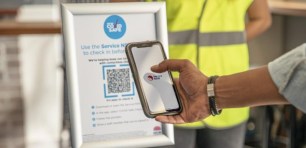
Source: Inside Retail
QR codes are once again on our radars with the news that eftpos’ eQR system will be hitting registers in stores like Coles and Woolworths before Christmas. While it could seem QR codes are still a novelty, this overnight success story is, in fact, nearly 20 years in the making.
The technology, developed in 1994 by a Japanese automotive company, was hardly used in Australia until the last 18 months, except for ticketing and the occasional marketing novelty. Before 2020, the idea of using a ‘quick response’ or QR code for any type of transactional function was far-fetched and unnecessary for most Australians.
And then came the pandemic.
QR codes have quickly become a regular part of life for most of us, and we now use those little squares to check-in everywhere we go for the purposes of contact tracing. But as Australia moves away from a COVID-zero strategy, and embarks on its roadmap out of lockdown, it looks as though the livelihood of the humble QR code is at a crossroads.
NSW Customer Service Minister Victor Dominello foreshadowed the end of QR code use for contact tracing late last month saying, “you’ve got to know when to turn QR codes on, but just as importantly, you’ve got to know when to turn them off”.
However, while governments may be winding up their use of QR codes as part of their COVID-19 response, the codes seem to have taken hold in other parts of our lives.
Filling a routine prescription with a GP now means a simple phone call and a QR code sent to your phone for the chemist to process. Digital menus and ordering platforms are now accessible via QR codes at many venues. And of course, digital vaccination certificates are set to be verified using QR codes in our shift to a ‘vaccine-led’ COVID-19 recovery.
Essential to international payments
But while Australians have a new appreciation for the quick response code, it has been a huge — and growing — part of the international payments landscape for a decade. A Juniper Research study earlier this year found that the number of QR code payment users globally will exceed 2.2 billion by 2025, the equivalent of just under 30% of all mobile phone users.
Any local merchant who has relied on income from tourism — particularly from Asia — knows the power of being able to transact via a wide range of payment methods, many of them QR code-enabled. Alipay, UnionPay, WeChat Pay, Doku Wallet, Kakao Pay — the list goes on.
In Australia, we have been a leader in the adoption of NFC (near field communication) payments with four in five consumers now using ‘tap and go’ to transact with the over 900,000 point-of-sale devices across the country each week.
But the leap from the early adoption of NFC payments to QR code payments methods hasn’t followed in a meaningful way.
An explanation for this could be that most Australians are reassured by our reliable and robust banking system, and don’t question institutions’ lack of technological innovation. The system works – thus there is little motivation to adopt newer technologies in the digital payments space.
Given the modest beginnings of the ‘static’ QR code, where the pattern stays the same and always links to the same service, there have also been misgivings in the past about how the transaction method meets the stringent security standards of the banking sector.
However, the industry standard for financial transactions has shifted to ‘dynamic’ QR codes, where a new pattern is uniquely generated each time it is used and can be edited at any time, in real time. Dynamic codes can also include additional protections such as access management and password protection, and can also deliver more detailed transaction information to operators.
In effect, QR codes are not only convenient, but highly secure.
Future-proofing with QR codes
The payments landscape is changing quickly. With any shift in technology, adoption is driven by customers who want to use their payment of choice — whether it be online or at the point of sale.
Businesses who have been at the mercy of the ever-changing conditions driven by the pandemic are acutely aware that every dollar counts, which means being able to accept payment in every possible form.
Whether the QR code is here to stay, or merely a novelty feature of a once in a generation pandemic, the technology should pique the interest of any merchant who is future proofing their business. In the shifting payments landscape, success will hinge on thinking strategically about catering to all customer preferences at the point of sale.
Handpicked for you

Service NSW QR code check-in system will be mandatory for NSW businesses



COMMENTS
SmartCompany is committed to hosting lively discussions. Help us keep the conversation useful, interesting and welcoming. We aim to publish comments quickly in the interest of promoting robust conversation, but we’re a small team and we deploy filters to protect against legal risk. Occasionally your comment may be held up while it is being reviewed, but we’re working as fast as we can to keep the conversation rolling.
The SmartCompany comment section is members-only content. Please subscribe to leave a comment.
The SmartCompany comment section is members-only content. Please login to leave a comment.